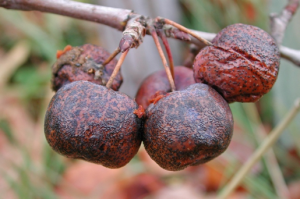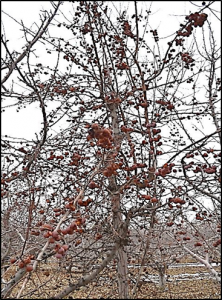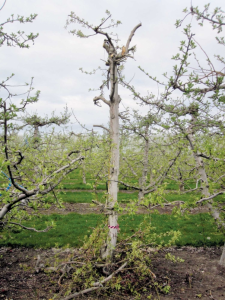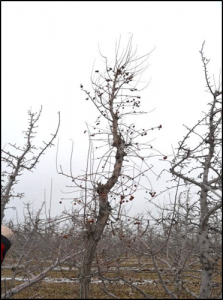Dr. Parama Sikdar, WSU Tree Fruit Research and Extension; Tianna DuPont, WSU Tree Fruit Extension Specialist
In 2012 China closed their doors to US apples because of three diseases Bull’s eye Rot, Speck Rot (Phacidiopycnis washingtonensis) and Sphaeropsis Rot (Sphaeropsis pyriputrescens). Markets have re-opened but the concern remains. Growers should consider using new integrated programs which include managing pollinizer trees.
Why are quarantine fruit rots a problem?
These fruit rots can cause large losses. In one especially bad lot 24% of the fruit were lost[1]. Generally, losses are small, 3-5%. However, even a small percentage infection could lead to additional export shutdowns. Almost 30% of Washington apples are exported. Countries such as China that do not have these diseases present, and thus have quarantines in place to keep the disease from entering the country. They require preventative management to reduce the risk of infected fruit entering the country. If infected fruit is detected in an exported shipment,the entire lot could be rejected and there is risk that imports could be restricted again.
Where do quarantine fruit infections start and when do symptoms develop?
P. washingtonensis and S.pyriputescens overwinter in the orchard and produce a reproductive structure called a pycnidia in dead decaying twigs or on cankers and in mummified fruit. Under the microscope a pycnidia oftentime looks like a a Hershey kiss. The ‘flag’ of the Hershey kiss are spores leaking out the top. In the orchard to the naked eye they look like small raised black dots, often surrounded by decayed tissue. These small black dot like structures are the source of the infection the next year. During the growing season spores can spread from one tree to other in the orchard and from pollinizer trees to crop trees via water from irrigation or rain. Fruit do not display symptoms on the tree. However the infection occurs in the orchard. It can occur at any time during the growing season. Fruit infections occurring closest to harvest have a higher incidence of rot in storage. Symptoms develop in storage and appear as stem- and calyx- end firm rots.
Often the disease is overwintering in the orchard in pollinator trees. Manchurian crabapple, which is the most commonly used pollinator in the State is highly susceptible. In the past Manchurian crabapple tree was generally not pruned resulting in dense woody trees with overhanging limbs.

Why is Manchurian crabapple of particular interest?
Manchurian crabapple is highly susceptible to quarantine diseases. “The crabapple fruit can be covered in millions of spores of the fungus,” says WSU plant pathologist Parama Sikdar.
Additionally, as a pollinizer it is generally not managed. Bushy, unmanaged trees can have many cankers and mummies that can produce inoculum.
Use a systems approach to prevent fruit rots.
Generally, crabapple trees are left unpruned. Unpruned crabapples are bushy and many branches hang over crop plants where spores can easily move onto crop trees.
- Start pruning crabapple in the spring if possible. Once you have assessed that you have sufficient bloom this is a good time to prune. Winter pruning is also effective.
- Prune at twig dieback.
- Remove dead crabapple fruit from pollinizers. These ‘mummies’ are a source of infection.
- When pruning crabapple trees try to remove twigs that overhang crop trees to slow movement of spores from the pollinators onto crops.
- Remove dead or damaged limbs as well as twigs with cankers.
- Make sure that pruned plant parts are carried out of the orchard.

Preharvest fungicides such as Ziram, Pristine or Topsin M applied near harvest as a ground applied can reduce Speck rot and Sphaeropsis rot. A postharvest fungicide drench with Penbotec (pyrimethanil), Scholar (fludioxonil) or Mertect (thiabendazole) is very effective in controlling both of these diseases. In general, these three postharvest fungicide treatments are more effective than the pre-harvest fungicide sprays.


